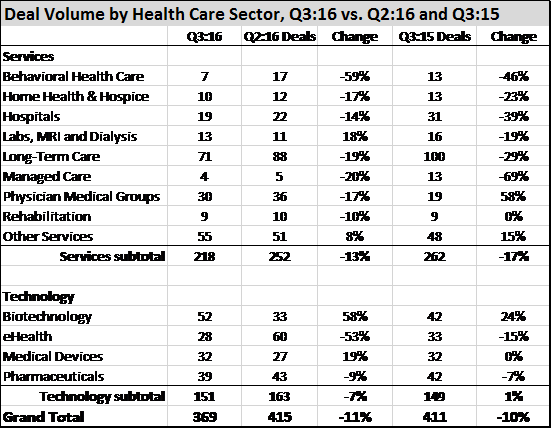Brace yourself. The third quarter results for health care mergers and acquisitions signal a hard tap on the brakes, both in deal volume and value. That’s compared with the robust second quarter, and the same quarter a year ago.
Before we go any further, though, we must note that, compared with all previous third quarters stretching back to 2000, the third quarter of 2016 doesn’t look that bad.
Some 369 transactions are now on the books for Q3:16, which ranks this quarter as the second-highest in deal volume for any previous third quarter. The top-ranked third quarter, coincidently, came a year ago, when Q3:15 racked up 411 transactions. So Q3:16’s deal volume slid 10% compared with the same quarter year-over-year. It also declined 11% compared with the second quarter’s 415 transactions.

Spending is always a different matter, because financial terms are not disclosed for the majority of healthcare deals. In the most recent third quarter, nearly $48.0 billion was spent on these transactions. Most other years, that would be a respectable, though not spectacular, showing.
In recent years, however, spending became so out-sized that Q3:16’s total appears to presage disaster. It’s down 46% compared with the second quarter’s $88.3 billion, and off 75% from Q3:15’s $193.5 billion. We have to go back to the third quarter of 2012 to find a lower quarterly total ($37.6 billion then).
Here’s where context comes in. In Q3:16, eight of the 132 deals with announced prices weighed in at $1.1 billion or higher, with Pfizer’s (NYSE: PFE) $13.5 billion acquisition of Medivation (NASDAQ:MDVN) being the largest deal.
In Q2:16, 172 deals disclosed prices, and 11 of those were $1.0 billion or higher. Two were over $10 billion, with Abbott’s (NYSE: ABT) $30.7 billion purchase of St. Jude Medical (NYSE: STJ) as the largest. Quintiles’ (NYSE: Q) $12.9 billion hook-up with IMS Health Holdings (NYSE: IMS) was the second largest. Those two deals alone ($43.9 billion) equal 91% of the entire third quarter’s spending.
The situation looks dire when compared with last year’s third quarter. But that could change by early 2017, and here’s why. Of the 411 deals announced then, 209 disclosed prices. Of those 209, 16 were more that $1.0 billion. Three of those deals were in the mega-billion-dollar category: The $54.2 billion acquisition of Cigna (NYSE: CI) by Anthem (NYSE: ANTM); Teva’s (NYSE: TEVA) $40.5 billion deal for Allergan’s (NYSE: AGN) generic drug business, and Aetna’s (NYSE: AET) $37 billion merger with Humana (NYSE: HUM).
Only one of those deals has closed, as Teva took nearly a year to satisfy the Federal Trade Commission’s conditions to approve the deal. The U.S. Department of Justice has challenged the two health insurance mergers, and there’s even speculation that some parties would like to call off their agreement. Anthem and Cigna have accused each other of breaching the merger deal, and the judge has split the trial into two sections, one focused on the national impact if the merger goes through, and one on the local market impact. Trials begin in November 2016, and decisions are not expected until 2017. Things could go south very quickly, and some $91 billion would be erased from Q2:15’s total spending.
2016 Volume Trends
Looking over the first three quarters of 2016, some trends have taken shape that, if they continue, could spell a quiet end to the year. Deal volume in the services sectors has drifted steadily downward since the first quarter, when services accounted for 62% of the 373 deals announced in Q1:16. Services made up 59% of the third quarter’s deal volume. Only the Laboratories, MRI & Dialysis sector and the Other Services sector showed gains in the third quarter, compared with the previous two. Investors have been moving into diagnostics and clinical laboratories, in particular.
Spending took a sharper dive in the third quarter, dropping 41% compared with Q1:16 ($80.7 billion) and 46% compared with Q2:16. The technology sectors typically make up the lion’s share of deal value in a quarter, and that held true in all three quarters. However, spending tanked in Q3:16. The tech sectors accounted for 81% of the total in Q1:16 ($65.2 billion) and 82% in Q2:16 ($72.1 billion). In Q3:16, they made up 58%. Buyers, especially in the pharma space, are likely waiting to see the outcome of next month’s election. We are, too. □

